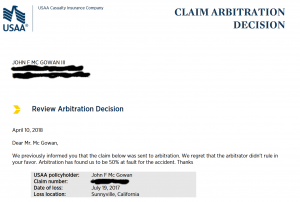I received the results of the arbitration for my mysterious automobile accident. According to USAA, my insurance company, the other driver also claimed to have had a green light. The arbitration appears to have split the fault down the middle:

This again raises the possibility that the light was green in both directions, for both drivers, whether due to a malfunction or tampering with the light. It is an intersection with multiple lights in each direction so both drivers should have been able to see the lights clearly. A prudent driver coming from the other driver’s direction would not have run the light intentionally since I was hidden behind a building. It is not possible to tell it is “safe” to run the light. Similarly, because of the divider which has many trees, I could not see the other driver approaching. A prudent driver in my position also would not make a decision to run the light.
My recollection is that I came to a full stop at a red light, waited until it changed, and made my left turn and was very surprised to see an oncoming car. Perhaps the other driver was confused or distracted, but it is definitely possible that they also had a green light. Modern traffic lights are complex computerized, networked devices. Such devices can have weird software glitches. They can also be hacked into.
About Me
John F. McGowan, Ph.D. solves problems using mathematics and mathematical software, including developing gesture recognition for touch devices, video compression and speech recognition technologies. He has extensive experience developing software in C, C++, MATLAB, Python, Visual Basic and many other programming languages. He has been a Visiting Scholar at HP Labs developing computer vision algorithms and software for mobile devices. He has worked as a contractor at NASA Ames Research Center involved in the research and development of image and video processing algorithms and technology. He has published articles on the origin and evolution of life, the exploration of Mars (anticipating the discovery of methane on Mars), and cheap access to space. He has a Ph.D. in physics from the University of Illinois at Urbana-Champaign and a B.S. in physics from the California Institute of Technology (Caltech).
